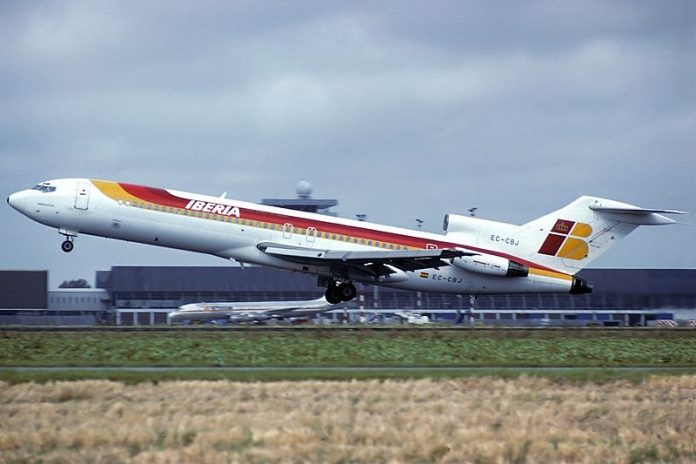The anniversary of a largely forgotten airline crash is worth remembering, mainly because this type of crash is much less frequent today.
Yesterday was the 34th anniversary of the destruction of Iberia Airlines flight 610 that crashed into a television antenna on approach to landing, in Bilbao, northern Spain, killing all 141 passengers and seven crew on board.
On 19 February 1985, the Boeing 727 was on a standard approach into Bilbao at 4300 feet when the crew switched on the altitude alert system while flying through overcast and rainy weather. At 09:09 the crew received permission to descend to 4300 feet and at 09:16 the first officer established contact with the tower of Bilbao airport. The controller gave permission for the aircraft to continue its descent: ‘Iberia 610, you can continue descending to Bilbao, approach to ILS, runway 30, wind 100 degrees 3 knots, airfield pressure 1025, descend to a height of 70 (about 7000 feet)’.
The crew repeated the transmitted information, after which the controller offered them a direct approach. However, the captain refused, choosing a standard approach. At 09:22 the crew reported on the VOR passage of Bilbao at an altitude of 7000 feet, reaching the starting point of the landing approach. The crew received permission to descend to an altitude of 5000 feet. This was the last radio transmission from flight 610.
The aircraft reached 5000 feet at 09:25. Minimum sector altitude in the region was 4354 feet, but the crew set the altitude on the warning system to 4300 feet. However, after reaching this altitude the plane continued descending. The weather was cloudy with fog, with 2.5 miles (4 km) of visibility. The autopilot controlled the descent. The terrain alarm went off when the plane reached 4040 feet; the captain interpreted this to be the approach alert mode alarm and ignored it and continued the descent. At 09:27, 177 feet above Mount Oiz (elevation 3356 feet) in a landing configuration, and at a speed of 208 knots, the aircraft collided with a television antenna tower, shearing off its left wing. The aircraft then crashed into a forest killing everyone on board.
The investigation found the crew forgot to turn on the ALT SEL button, accidentally disengaged it, or the system itself malfunctioned. There was also ‘probable misreading’ of the 737’s multi-needle altimeter. As a result, after reaching their assigned altitude, the autopilot did not level the aircraft, which led to a further descent, and the pilots did not notice or control this. When the ground proximity warning system activated and sounded the ‘pull up’ alarm, the crew most probably misinterpreted this. Investigators also discovered that the TV tower installed on the mountain was not marked on the navigation maps available to the crew.
Controlled flight into terrain (CFIT) was a regular destroyer of airliners in the first generations of jet aircraft. In 1974, the CFIT risk was about one large commercial aircraft for every 800,000 flights. By 2003, this had reduced by a factor of 100 to less than one loss for every 91 million flights. Although training had improved, pilots, being human, had not stopped making mistakes during that period. The difference was the result of Enhanced Ground Proximity Warning Systems (EGPWS) (also known as Terrain Awareness Warning Systems [TAWS]) that used GPS-generated maps and predictive algorithms to give accurate warning of terrain ahead. Previous ground proximity warning systems could be ‘caught out’ by the aircraft being in a landing configuration, or by steep slopes, which their downward facing sensors could not detect in time. Standardised and trained EGPWS alert recovery procedures also contributed to the decline.
CFIT accidents have become exceedingly rare, although not unknown. The destruction of a Sukhoi Superjet 100 that crashed into an Indonesian volcano on a demonstration flight in 2012 was one of a handful of 21st century instances. Like Iberia flight 610, it involved the crew misinterpreting a warning.
The unfortunate passengers and crew on flight 610 were among the last to die in a jet airliner CFIT crash. It’s appropriate to remember them and think about how many more would have shared their fate if not for the development and mandating of EGPWS/TAWS.



only 5 years later… https://en.wikipedia.org/wiki/Alitalia_Flight_404
Pilots make thousands of errors daily world wide, we hear virtually nothing of them, most had the chain link broken, a report goes in and that’s that! It’s only a matter of time before another airframe is scattered across some hillside somewhere with bodies littering the countryside, human nature to fcku it up!
Very impressive improvements, ‘By 2003, this had reduced by a factor of 100 to less than one loss for every 91 million flights’. Our children and grandchildren will continue to be beneficiaries of these sort of safety improvements.
Hmmh!
GPWS was already available in 1985 when this accident occurred. It was being used in Dan Air London’s 727 that crash in Tenerife in 1980. So, why wasn’t this Iberia crew warned by GPWS?